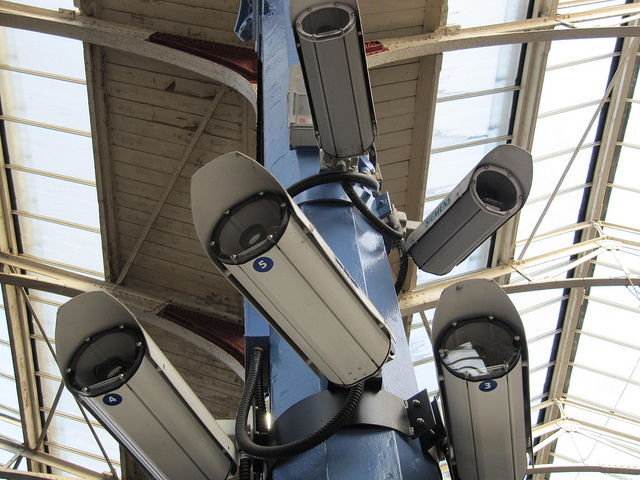Surveillance is reconfiguring the way that we live our lives
Emmeline Taylor has been documenting the steadily rising use of new technologies with surveillance capabilities in UK schools and schools around the world. In this extract from her recent interview with Sonali Campion, she describes the way in which these technologies are reshaping young people’s expectations of privacy, trust in others and social interactions.

What has been the impact of the use of CCTV surveillance in schools? Credit: greensambaman, CC BY-NC-ND 2.0
You talk about students in the UK being coerced into accepting CCTV and other forms of surveillance. Could you describe some of the impacts this is having and some of the reactions against it?
Since September 2013 schools have been required under the Protection of Freedoms Act 2012 to get parental consent before they process a child’s biometric data. Prior to the passing of that Act, there was no explicit direction for schools to even inform parents, let alone seek permission and that’s really how fingerprinting began to flourish in our schools. What would typically happen is that a school would purchase the fingerprinting equipment, and a member of staff would sit at a desk and the pupils would line up and one by one be asked to place their finger for the record to be taken. But there was not necessarily any explanation as to the multiple ways that this data was going to be used, or any opportunity to opt out. It just didn’t follow what you would expect the normal processes to be. I think any nine-year old who’s asked to present their finger by their teacher is going to comply; it would take a pretty savvy child to begin to think “hang on a minute, should I be doing this, what are the implications, what’s going to happen to this information?”
Some parents became aware of what was happening and did try to opt out of the system. But they were then treated quite heavy-handedly by the schools, who said “OK, fine, we won’t register Molly’s fingerprints, but that means she can’t have a hot dinner because our whole canteen system now relies on having this biometric data. We’re not going to take cash anymore so unless you give us her fingerprints, you’re going to have to make her a packed lunch every day. She won’t be allowed to come into the canteen, she’ll have to sit outside to eat her lunch…” Children began to be punished if either they or their parents didn’t want to buy in to the biometric system. Coercion was typical of the way that many of these systems were rolled out.
What message is this teaching young people? If you do think about the “hidden curriculum” and the messages pupils internalise at school, it is basically telling them that we don’t live in a democratic society. It says don’t question these systems or you’ll be punished. And that plays out with many different types of surveillance. In America, for example, there’s been lots of protests about the use of CCTV and the use of micro-chipping in schools, and the response is always so punitive that it teaches young people at a critical time in their lives that you either conform or you get punished.
How are these types of surveillance in schools affecting young people’s social development?
Surveillance can create an environment which teaches young people to self-regulate constantly, instead of having freedom of expression or the space to test out new ideas and opinions. It’s eroding the freedom to get things wrong as well, that it’s OK to make mistakes, that you can be a child, that you can mess about and have jokes and all these types of things. The disciplinary power within these surveillance technologies is so strong. Are we really allowing the kids the space just to be kids?
One of the case studies that I talk about in the book happened in a primary school. A child had hidden another girl’s pair of shoes and when the teacher said “have you hidden them? Where have you put them?” and didn’t get a response, then it was “OK, then I’ll go and check the CCTV”. And what is really concerning there is this idea that you can no longer take young people at their word, because you then go and seek validation, whether that’s through biometrics, CCTV footage or micro-chipping people. That has a huge implication for the way that people interact with one another, and how we construct trust in our everyday interactions.
What about surveillance in relation to teachers? How much this is being used to monitor their behaviour and the quality of their teaching?
Initially school surveillance was very much centred on young people, but recently we’re seeing through a process of ‘surveillance creep’, the focus shifting to teachers.
There are a few schools, for example in Salford in Greater Manchester where the CCTV has been explicitly used for teacher training purposes, and it actually has microphones recording audio from the classroom as well. Somebody is monitoring the screen and giving the teacher live feedback, whether that’s to say, for example, “somebody in the third row is talking behind your back every time you write something on the whiteboard”, or whether it’s to say “we don’t think you explained that concept sufficiently”.
I think surveillance in schools is closely linked to the Michael Gove neoliberal school ideal, where everything is measurable and quantifiable at the expense of a nurturing, creative and democratic environment where teachers have professional discretion. So I think we’re going to see the surveillance of teachers more and more and it’s likely that we will see teachers resisting as the gaze shifts to them.
How should we moderate surveillance in schools? Because, as you say in your book, we’re not going to get rid of all of it and that there is actually some value to it.
There needs to be a system whereby schools must apply to use technologies that are particularly invasive such as CCTV in the pupils’ toilets or those that process sensitive biometric data, so it forces the school to create a business case and consider whether it is a proportionate response to the objective identified. It could involve a cost-benefit analysis, and I don’t just mean in economic terms, but exploring the impact it could have on privacy, trust, freedom of expression and association etc. We need to replace the fallacious claims about the effectiveness of some of these systems and ensure that schools really question if the technology can do what the sales pitch tells them it can do. For example, is biometric fingerprinting really going to prevent bullying and where’s the evidence for that? It can’t just be an ill-informed or whimsical decision to introduce these technologies that radically change the school environment.
There needs to be some form of moderator that helps schools to think through whether these are logical and rational decisions to make. There is an Information Commissioner obviously, but also now there’s a Surveillance Commissioner. So far they’ve been very hands off and haven’t really commented on the use of surveillance in schools in particular, but perhaps they could take on a more active role. There needs to be regulation.
One of the things that I feel really strongly about is that surveillance needs to be on the curriculum. Because it’s everywhere, and it really is reconfiguring the way that we live our lives. I think young people are still not as digitally literate as perhaps they should be. How do you interact with these technologies? What do they mean? What sort of things should you be cautious of? Just really understanding what surveillance is, the numerous ways in which personal data is now captured, and what their rights and expectations as citizens should be.
We’ve got a very limited window of opportunity to educate the next generation about the values that are being usurped by surveillance practices. There is a very strong normalisation process embedded in surveillance – we’re habituating young people to having these surveillance mechanisms as an everyday part of their lives. When I talk to people who are maybe sixteen or seventeen, and I ask them “how does it feel having a police officer patrolling the corridors or a CCTV camera in the classroom” and they say, well it’s just normal we have to accept it. They’ve never really known anything different. So they don’t question necessarily the direct link that they have with the criminal justice system, and whether that does correlate with an increasing prison population. They don’t have that critical discourse that enables them to question it.
Only time will tell how surveillance in schools might develop in the not-too-distant future as its use becomes normalised, as surveillance technologies get cheaper and more pervasive, and as neoliberalism cements the link between corporatization and education. There needs to be public debate about why this is happening. The technology is becoming much more sophisticated but it’s not being matched by a demand to really understand what the implications of introducing military grade surveillance systems into our schools are.
—
Note: This post was originally published on the LSE British Politics and Policy blog. It represents the views of the interviewee and does not give the position of Democratic Audit or the LSE. Please read our comments policy before responding.
—
 Emmeline Taylor is a senior lecturer in the School of Sociology at The Australian National University. Emmeline’s scholarship spans a range of criminological areas including; domestic burglary, armed robbery, retail crime, CCTV and surveillance technologies. She is the author of Surveillance Schools: Security, Discipline and Control in Contemporary Education (Palgrave Macmillan, 2013).
Emmeline Taylor is a senior lecturer in the School of Sociology at The Australian National University. Emmeline’s scholarship spans a range of criminological areas including; domestic burglary, armed robbery, retail crime, CCTV and surveillance technologies. She is the author of Surveillance Schools: Security, Discipline and Control in Contemporary Education (Palgrave Macmillan, 2013).





 Democratic Audit's core funding is provided by the Joseph Rowntree Charitable Trust. Additional funding is provided by the London School of Economics.
Democratic Audit's core funding is provided by the Joseph Rowntree Charitable Trust. Additional funding is provided by the London School of Economics.
Surveillance is reconfiguring the way that we live our lives – https://t.co/hoAz0rq14u #biz
How has surveillance changed our lives? https://t.co/4uRMQpjmvK
“surveillance needs to be on the curriculum…it really is reconfiguring the way we live our lives” https://t.co/md8tZmblOx” HT @PJDunleavy
Surveillance is reconfiguring the way that we live our lives https://t.co/4xc349ttvi
“@LSEPubAffairs: Surveillance is reconfiguring the way that we live our lives https://t.co/Mu6vVrBeL6” Surveillance in schools etc….
Surveillance is reconfiguring the way that we live our lives https://t.co/dQfa71P6d5